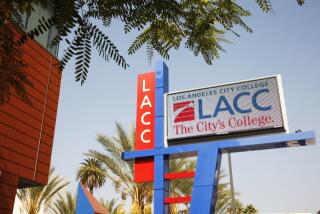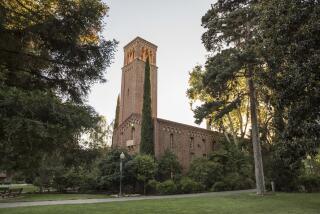Tuition That Oinks
ST. CHARLES, Mo. — The gorgeous new dining hall at Lindenwood University serves pizzas hot from a wood-fired oven, turkey breast carved to order by a chef, platters of fresh-baked cookies and pie.
But it’s the pork chops dished out at the steaming Comfort Food Station that keep junior Benton Haines in school. It’s not that he particularly likes them -- he’s picky about his meals -- but the pork chops are paying his tuition.
In a program that holds out thought for food, Lindenwood University now takes payment in pigs.
As the stumbling economy drags down the small farm towns surrounding the college -- towns that for decades proudly sent their top students to Lindenwood -- President Dennis Spellmann has reached out with an offer to barter. He’ll trade a liberal arts education at his small private college -- retail value, $11,200 a year -- for any commodity the dining hall can use.
Six families so far have swapped their swine for scholarship, trading hogs that are worth little on the open market for classes in business or education on Lindenwood’s tree-lined suburban campus. In the bargain, they’ve filled the cafeteria’s freezers with fresh-off-the-farm sausage, bacon -- even whole pigs, which are smoked on an outdoor barbecue spit before home football games.
“I often wondered if that was dad’s pig up there,” said Sally Miller, 24, a kindergarten teacher who paid in hogs for her last two years at Lindenwood.
Now Spellmann is on a mission to expand the 3-year-old program; he’s hoping to bring 50 barter students a year to Lindenwood. He’s promoting the deal to rural school superintendents. He’s pushing it with agricultural trade groups. He’s even advertising in the Farm Journal. “Pork: The Other Tuition Payment.”
The offer is well-timed, and not just because farmers are struggling. In the last two decades, college tuition has soared. Even adjusting for inflation, the average tuition more than doubled at public and private universities from 1981 to 2001, according to the College Board. Median family income rose just 25%.
Scholarships cannot fill the gap. Take the Pell Grant, a federal program for needy students. The average grant covered 98% of tuition in 1986 but less than 60% in 1999, according to the National Center for Public Policy and Higher Education, based in San Jose.
The typical graduate leaves college carrying $18,000 in debt.
To help parents shaken by such numbers, college administrators have begun to get creative.
“You’re seeing a pattern of ingenuity,” said David L. Warren, president of the National Assn. of Independent Colleges and Universities.
Defiance College in Defiance, Ohio, will cut tuition for top students who pledge to spend several hours a week in volunteer work. Students who cheer on the college’s sports teams get a hefty discount at William Woods University in Fulton, Mo. And Clark University in Worcester, Mass., offers a free fifth year of education to pursue a master’s degree to all who maintain B+ averages as undergrads.
Dozens of colleges will freeze tuition when a freshman enrolls, shielding families from annual hikes. A few accept payments in monthly installments, or even let parents finance four years of tuition over a decade. A handful offer employment guarantees. College Misericordia in Dallas, Pa., will settle graduates in paid internships if they have not found good jobs within six months.
Then there’s barter -- an age-old practice that, to Spellmann, seems ripe for revival.
Lindenwood appears to be the only school engaging in direct swaps with parents. But a dozen other small private colleges have signed on with trading networks, also known as barter banks.
Members of such networks provide free labor and merchandise to one another. A central administrator keeps track of how much each member “deposits” in the barter bank (in the form of work he does for others) and how much he “withdraws” (in the form of services for himself).
As a member of the Green Apple Barter Service, La Roche College in Pittsburgh can trade scholarships for catered meals, construction work, advertising, or any number of other services. It doesn’t have to be direct barter, either. A parent who owns a ski shop could snatch up a scholarship, “paying” for it by giving away long underwear to a dentist, who might in turn fill cavities free for a carpenter, who might then build bleachers without charge for the college.
Frame store owner Al Houston paid for his son’s degree in chemistry that way, bartering $75,000 worth of his services to other members of the network in exchange for free tuition at La Roche.
“It was a godsend,” he said.
In the farm town of Silex, Mo., about a half-hour’s drive northwest of Lindenwood, Elaine Bruns echoes those words.
When hog prices tanked in 1998, she and her husband, Kurt, found themselves losing money on every animal they sold. They didn’t know how they could afford to keep their daughter, Sally Miller, studying for her degree in education.
That’s when Spellmann -- himself a farm kid, way back -- stepped in with the offer to barter.
He figured out how much the meat from one pig would cost the college on the wholesale market. He then discounted Sally’s tuition by that sum for every hog the Bruns delivered to a local slaughterhouse. The pigs were processed there, and the packaged meat sent on to the cafeteria.
Elaine Bruns figures her daughter’s junior and senior years cost the family about 50 hogs. Those animals would have brought in less than $4,500 at auction. To have them cover $22,000 in college tuition is almost more than she can believe.
“It was such a relief,” she said.
Plus, she knew Sally was eating well at school. Especially on days when the menu boasted “Missouri roast pork.”
“We were proud of that too,” Bruns said. “You bet.”
“The program makes good sense for everyone,” said Rex Haines, who paid for a third of his son Benton’s tuition with pork chops and pork steaks this year.
For the record, the bartered bounty has not forced Lindenwood students into an all-pork diet. A few dozen hogs a year doesn’t begin to cover the daily meat demands at a school where vegetarians are few and far between.
“I would love to introduce California cuisine here, but if I were to serve squid-ink pasta, I’d sink to the bottom real quick. This is a meat and potatoes town,” explained Ralph Pfremmer, the food services director. (He does manage to sneak spinach-and-garlic tofu on the menu now and then.)
A formal protest by animal rights activists has not gained much traction on campus. People for the Ethical Treatment of Animals wrote Spellmann this fall, asking him to stop accepting “tortured pig carcasses” as tuition. He brushed off the plea. The rest of his mail has been overwhelmingly positive. Strangers have called him “heroic.” He has been bombarded with queries from would-be applicants: How many 4-H steers would pay for a year at Lindenwood? Could the dining hall use fresh lamb chops?
“One community in the Ozarks came to me and said, ‘We’ve got rocky soil here. We don’t grow a lot of stuff. But we want to send one or two top students a year to Lindenwood. What could we send you?’ I thought, well, they have a lot of cedar trees there. What if they could make bluebird houses and then I could sell them in a gift shop?” Spellmann mused.
He’s now negotiating with three families who want to pay in beef cattle. He’s also considering taking sheep, though personally, he’s not much for mutton.
Spellmann talks about barter as a way to help struggling families. But he is bluntly honest, as well, about how the system can help small private colleges. The number of students boarding at Lindenwood has tripled in the last decade, to 2,400. More than 9,000 others commute to the campus, which is just northwest of St. Louis. The school has gained a name in Missouri for its teacher training programs. It’s even earned a bit of athletic celebrity, with a national championship roller hockey team. The campus quadrangle buzzes all day as students spill out of the century-old brick classrooms onto shaded paths lined with wooden porch swings.
Yet when the economy slumps, as during the recent recession, undergraduates come into Spellmann’s office, telling him they’re going to have to quit school. Because the college’s fixed costs are so high -- professor salaries, building maintenance and so on -- each loss of a student is a blow.
“We treat every empty seat in a class, every empty bed in a dorm as an expense,” Spellmann said. “It’s almost like the economics of an airline. It costs the same amount to fly the plane whether it’s full or empty.”
If he can fly Lindenwood full, he wants to do it. If he can get fresh pork in the bargain, so much the better.
After all, bartering for education is nothing new. Colonial students at Harvard (think class of 1642) paid for courses with livestock, hardware, even boots. When Lindenwood opened in 1827, it accepted milk, potatoes and live chickens, stashed in a coop behind the dining hall.
The tradition persisted at some schools through World War II. One young woman who entered Stanford in the late 1940s reported that Brussels sprouts were served so incessantly, she was certain a fellow student had signed a bumper crop over to the bursar.
Such trades faded from fashion soon after, as programs such as the GI Bill and Pell Grants emerged.
Yet many students at Lindenwood applaud the revival of barter, and only wish they could find a way to cut a deal for themselves.
“I owe the school quite a bit,” senior Tom Marvuli said. “Maybe I’ll bring back some fish the next time I go on vacation to the beach.”
More to Read
Sign up for Essential California
The most important California stories and recommendations in your inbox every morning.
You may occasionally receive promotional content from the Los Angeles Times.










